Creation of Tool Coatings Based on Titanium Diboride for Highly Efficient Milling of Chromium–Nickel Alloys
Abstract
1. Introduction
2. Materials and Methods
2.1. Technological Principles and Equipment for Spark Plasma Sintering of Targets from a Powder Composition Based on TiB2
2.2. Technological Principles and Equipment for Deposition of Coatings Based on TiB2
2.3. Experimental Samples of End Mills and a Method for Wear Resistance Assessing in Cutting
3. Results
3.1. Spark Plasma Sintering of Targets from a Powder Composition Based on TiB2
3.2. Deposition of TiB2-Based Coatings on Carbide Substrates
3.3. Wear Resistance of TiB2-Based Coatings Deposited on Carbide Substrates during Tribological Tests
3.4. Wear Resistance of TiB2-Based Coatings Deposited on Carbide End Mills When Tested in Cutting
4. Conclusions
Author Contributions
Funding
Data Availability Statement
Conflicts of Interest
References
- Yin, Q.; Liu, Z.; Wang, B.; Song, Q.; Cai, Y. Recent progress of machinability and surface integrity for mechanical machining Inconel 718: A review. Int. J. Adv. Manuf. Technol. 2020, 109, 215–245. [Google Scholar] [CrossRef]
- Bartolomeis, A.; Newman, S.T.; Jawahir, I.S.; Biermann, D.; Shokrani, A. Future research directions in the machining of Inconel 718. J. Mater. Process. Technol. 2021, 297, 117260. [Google Scholar] [CrossRef]
- Grguras, D.; Kern, M.; Pusavec, F. Suitability of the full body ceramic end milling tools for high speed machining of nickel based alloy Inconel 718. Procedia CIRP 2018, 77, 630–633. [Google Scholar] [CrossRef]
- Gusarov, A.V.; Migranov, M.S.; Mitrofanov, A.P.; Gusev, A.S.; Migranov, A.M.; Khmyrov, R.S. Effect of Surface Modification via Laser Irradiation on the Operability of Carbide End Mills When Cutting Aircraft Alloys. Coatings 2023, 13, 1823. [Google Scholar] [CrossRef]
- Sortino, M.; Belfio, S.; Totis, G.; Kuljanic, E.; Fadelli, G. Innovative Tool Coatings for Increasing Tool Life in Milling Nickel-coated Nickel-Silver Alloy. Procedia Eng. 2015, 100, 946–952. [Google Scholar] [CrossRef][Green Version]
- Yu, J.; Wang, Y.; Zhao, X.; Li, Q.; Qiao, Q.; Zhao, J.; Zhai, S. Wear Resistance of Ni-Based Alloy Coatings. Adv. Mater. Sci. Eng. 2019, 2019, 1–7. [Google Scholar] [CrossRef]
- Liu, Y.; Li, Z.; Li, G.; Tang, L. Friction and wear behavior of Ni-based alloy coatings with different amount of WC–TiC ceramic particles. J. Mater. Sci. 2023, 58, 1116–1126. [Google Scholar] [CrossRef]
- Grigoriev, S.; Vereschaka, A.; Zelenkov, V.; Sitnikov, N.; Bublikov, J.; Milovich, F.; Andreev, N.; Mustafaev, E. Specific features of the structure and properties of arc-PVD coatings depending on the spatial arrangement of the sample in the chamber. Vacuum 2022, 200, 111047. [Google Scholar] [CrossRef]
- Yuan, J.; Yamamoto, K.; Covelli, D.; Tauhiduzzaman, M.; Arif, T.; Gershman, I.; Veldhuis, S.; Fox-Rabinovich, G. Tribo-films control in adaptive TiAlCrSiYN/TiAlCrN multilayer PVD coating by accelerating the initial machining conditions. Surf. Coat. Technol. 2016, 294, 54–61. [Google Scholar] [CrossRef]
- Alamgir, A.; Yashin, M.; Bogatov, A.; Viljus, M.; Traksmaa, R.; Sondor, J.; Lümkemann, A.; Sergejev, F.; Podgursky, V. High-Temperature Tribological Performance of Hard Multilayer TiN-AlTiN/nACo-CrN/AlCrN-AlCrO-AlTiCrN Coating Deposited on WC-Co Substrate. Coatings 2020, 10, 909. [Google Scholar] [CrossRef]
- Lim, C.S.; Sofer, Z.; Mazanek, V.; Pumera, M. Layered titanium diboride: Towards exfoliation and electrochemical applications. Nanoscale 2015, 7, 12527–12534. [Google Scholar] [CrossRef] [PubMed]
- Gild, J.; Zhang, Y.; Harrington, T.; Jiang, S.; Hu, T.; Quinn, M.C.; Mellor, W.M.; Zhou, N.; Vecchio, K.; Luo, J. High-Entropy Metal Diborides: A New Class of High-Entropy Materials and a New Type of Ultrahigh Temperature Ceramics. Sci. Rep. 2016, 6, 37946. [Google Scholar] [CrossRef] [PubMed]
- Casais, R.; Baptista, A.M.; Silva, F.J.; Andrade, F.; Sousa, V.; Marques, M.J. Experimental study on the wear behavior of B4C and TiB2 monolayered PVD coatings under high contact loads. Int. J. Adv. Manuf. Technol. 2022, 120, 6585–6604. [Google Scholar] [CrossRef]
- Grishin, A.M.; Putrolaynen, V.V. Hard and Highly Adhesive AlMgB14 Coatings RF Sputtered on Tungsten Carbide and High-Speed Steel. Materials 2023, 16, 6930. [Google Scholar] [CrossRef] [PubMed]
- Chowdhury, M.S.I.; Bose, B.; Fox-Rabinovich, G.; Veldhuis, S.C. Investigation of the Wear Performance of TiB2 Coated Cutting Tools during the Machining of Ti6Al4V Alloy. Materials 2021, 14, 2799. [Google Scholar] [CrossRef]
- Schalk, N.; Tkadletz, M.; Mitterer, C. Hard coatings for cutting applications: Physical vs. chemical vapor deposition and future challenges for the coatings community. Surf. Coat. Technol. 2022, 429, 127949. [Google Scholar] [CrossRef]
- Sroba, V.; Fiantok, T.; Truchly, M.; Roch, T.; Zahoran, M.; Grancic, B.; Svec, P.; Nagy, S.; Izai, V.; Kus, P.; et al. Structure evolution and mechanical properties of hard tantalum diboride films. J. Vac. Sci. Technol. A 2020, 38, 033408. [Google Scholar] [CrossRef]
- Grigoriev, S.N.; Volosova, M.A.; Vereschaka, A.A.; Sitnikov, N.N.; Milovich, F. Properties of (Cr,Al,Si)N-(DLC-Si) composite coatings deposited on a cutting ceramic substrate. Ceram. Int. 2020, 46, 18241–18255. [Google Scholar] [CrossRef]
- Rao, J.; Cruz, R.; Lawson, K.J.; Nicholls, J.R. Carbon and titanium diboride multilayer coatings. Diam. Relat. Mater. 2004, 13, 2221–2225. [Google Scholar] [CrossRef]
- Lee, K.W.; Chung, Y.W.; Korach, C.; Keer, L.M. Tribological and dry machining evaluation of superhard TiB2/TiC multilayer coatings deposited on Si(001), M2 steel, and C3 WC cutting tool inserts using magnetron sputtering. Surf. Coat. Technol. 2005, 194, 184–189. [Google Scholar] [CrossRef]
- Levashov, E.A.; Mukasyan, A.S.; Rogachev, A.S.; Shtansky, D.V. Self-propagating high-temperature synthesis of advanced materials and coatings. Int. Mater. Rev. 2017, 62, 203–239. [Google Scholar] [CrossRef]
- Twardowska, A.; Podsiadło, M.; Sulima, I.; Bryła, K.; Hyjek, P. Microstructure and Properties of TiB2 Composites Produced by Spark Plasma Sintering with the Addition of Ti5Si3. Materials 2021, 14, 3812. [Google Scholar] [CrossRef] [PubMed]
- Shcherbakov, V.A.; Gryadunov, A.N.; Semenchuk, I.E.; Alymov, M.I. Ta4HfC5 Ceramic by Electro-Thermal Explosion under Pressure: Thermal and Electrical Parameters of the Process. Int. J. Self-Propag. High-Temp. Synth. 2022, 31, 1–5. [Google Scholar] [CrossRef]
- Oguntuyi, S.D.; Johnson, O.T.; Shongwe, M.B. Spark Plasma Sintering of Ceramic Matrix Composite of ZrB2 and TiB2: Microstructure, Densification, and Mechanical Properties—A Review. Met. Mater. Int. 2021, 27, 2146–2159. [Google Scholar] [CrossRef]
- Grigoriev, S.N.; Volosova, M.A.; Peretyagin, P.Y.; Seleznev, A.E.; Okunkova, A.A.; Smirnov, A. The Effect of TiC Additive on Mechanical and Electrical Properties of Al2O3 Ceramic. Appl. Sci. 2018, 8, 2385. [Google Scholar] [CrossRef]
- Cohen, S.; Ratzker, B.; Kalabukhov, S.; Frage, N. Diffusion bonding of transparent ceramics by spark plasma sintering (SPS) complemented by hot isostatic pressing (HIP). J. Eur. Ceram. Soc. 2023, 43, 6628–6633. [Google Scholar] [CrossRef]
- Rajguru, R.R.; Vasudevan, H. A study of micro hardness in the machining of Inconel 625 using TiAlSiN coated tools under dry cutting conditions. Adv. Mater. Process. Tec. 2022, 10, 120–130. [Google Scholar] [CrossRef]
- Yue, Q.B.; He, H.B.; Li, H.Y.; Zhang, J.; Li, Y.M.; Ma, L. Research on Friction Characteristics of AlCrN and TiAlSiN Coatings and Properties of Coated Tools. Int. J. Precis. Eng. Manuf. 2019, 20, 1581–1589. [Google Scholar] [CrossRef]
- Drobný, P.; Mercier, D.; Koula, V.; Škrobáková, S.I.; Čaplovič, Ľ.; Sahul, M. Evaluation of Adhesion Properties of Hard Coatings by Means of Indentation and Acoustic Emission. Coatings 2021, 11, 919. [Google Scholar] [CrossRef]
- Vithal, N.D.; Krishna, B.B.; Krishna, M.G. Impact of dry sliding wear parameters on the wear rate of A7075 based composites reinforced with ZrB2 particulates. J. Mater. Res. Technol. 2021, 14, 174–185. [Google Scholar] [CrossRef]
- Beake, B.D. The influence of the H/E ratio on wear resistance of coating systems–Insights from small-scale testing. Surf. Coat. Technol. 2022, 442, 128272. [Google Scholar] [CrossRef]
- Bouzakis, K.D.; Michailidis, N.; Skordaris, G.; Bouzakis, E.; Biermann, D.; M’Saoubi, R. Cutting with coated tools: Coating technologies, characterization methods and performance optimization. CIRP Annals 2012, 61, 703–723. [Google Scholar] [CrossRef]
- Storchak, M.; Zakiev, I.; Zakiev, V.; Manokhin, A. Coatings strength evaluation of cutting inserts using advanced multi-pass scratch method. Measurement 2022, 191, 110745. [Google Scholar] [CrossRef]
- Panjan, P.; Gselman, P.; Kek-Merl, D.; Čekada, M.; Panjan, M.; Dražić, G.; Bončina, T.; Zupanič, F. Growth defect density in PVD hard coatings prepared by different deposition techniques. Surf. Coat. Technol. 2013, 237, 349–356. [Google Scholar] [CrossRef]
- Panjan, P.; Drnovšek, A.; Kovač, J. Tribological aspects related to the morphology of PVD hard coatings. Surf. Coat. Technol. 2018, 343, 138–147. [Google Scholar] [CrossRef]
- Volosova, M.; Grigoriev, S.; Metel, A.; Shein, A. The Role of Thin-Film Vacuum-Plasma Coatings and Their Influence on the Efficiency of Ceramic Cutting Inserts. Coatings 2018, 8, 287. [Google Scholar] [CrossRef]
- Shuster, L.S.; Fox-Rabinovich, G.S.; Chertovskikh, S.V. Influence of Cutting Conditions on the Wear Resistance of Tools with a TiB2 Coating during Titanium Alloy Machining. J. Frict. Wear 2021, 42, 466–472. [Google Scholar] [CrossRef]
- Su, K.; Liu, D.; Pang, H.; Shao, T. Improvement on thermal stability of TiAlSiN coatings deposited by IBAD. Surf. Eng. 2017, 34, 504–510. [Google Scholar] [CrossRef]
- Kovalev, A.; Wainstein, D.; Konovalov, E.; Vakhrushev, V.; Fox-Rabinovich, G.; Fox-Rabinovich, M.; Dmitrievskii, S.; Tomchuk, A. Features of Tribooxidation of the High-Entropy Coating (AlCrZrTiTa)N during Dry High-Speed Cutting. Coatings 2023, 13, 1508. [Google Scholar] [CrossRef]
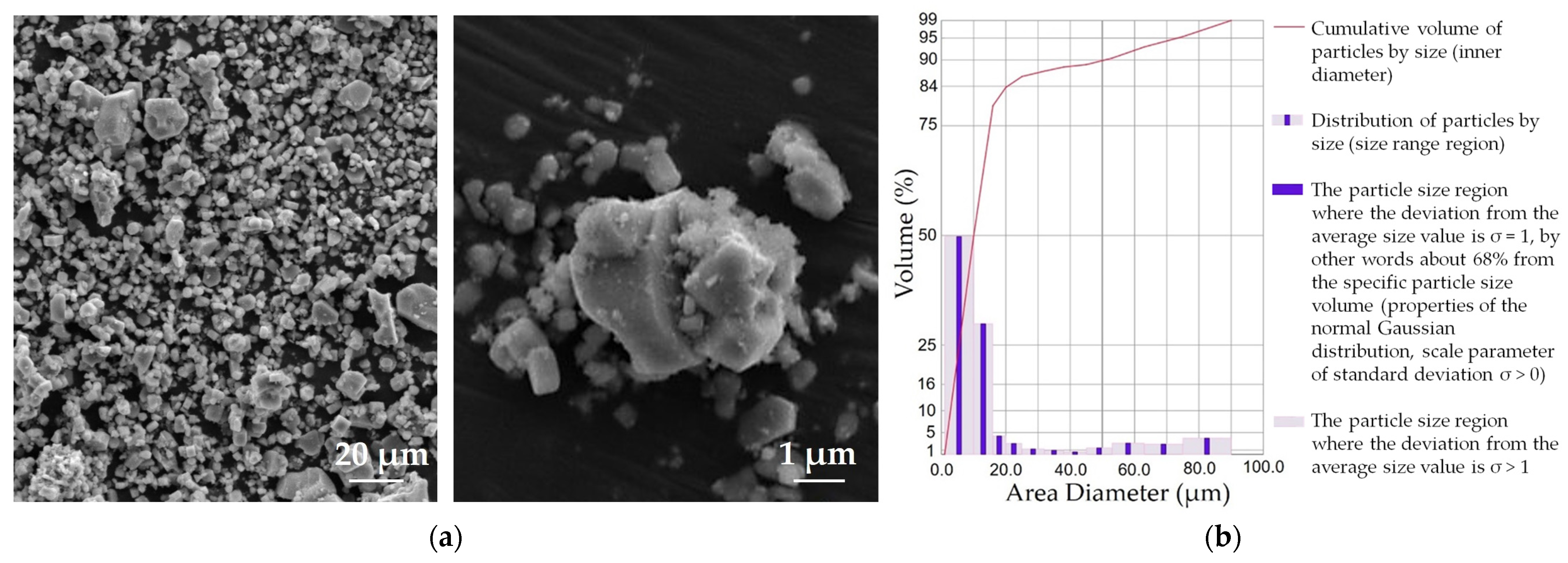
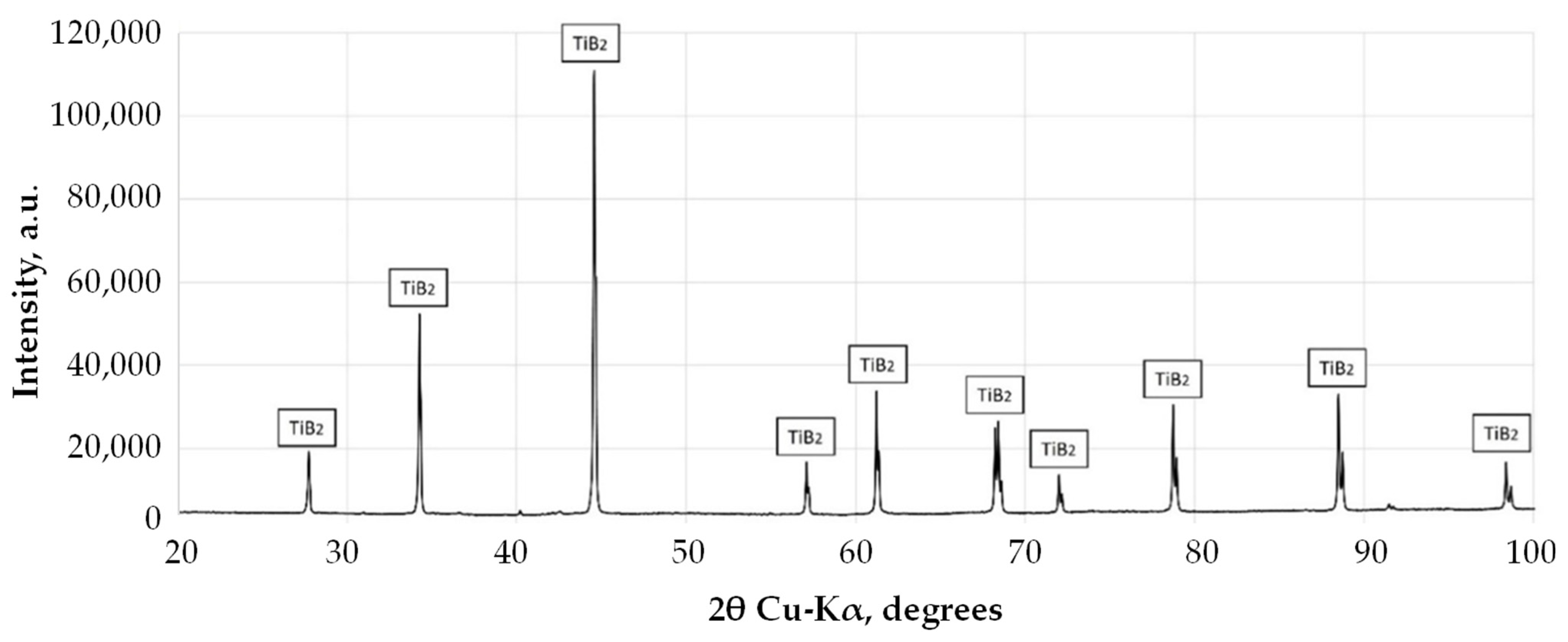
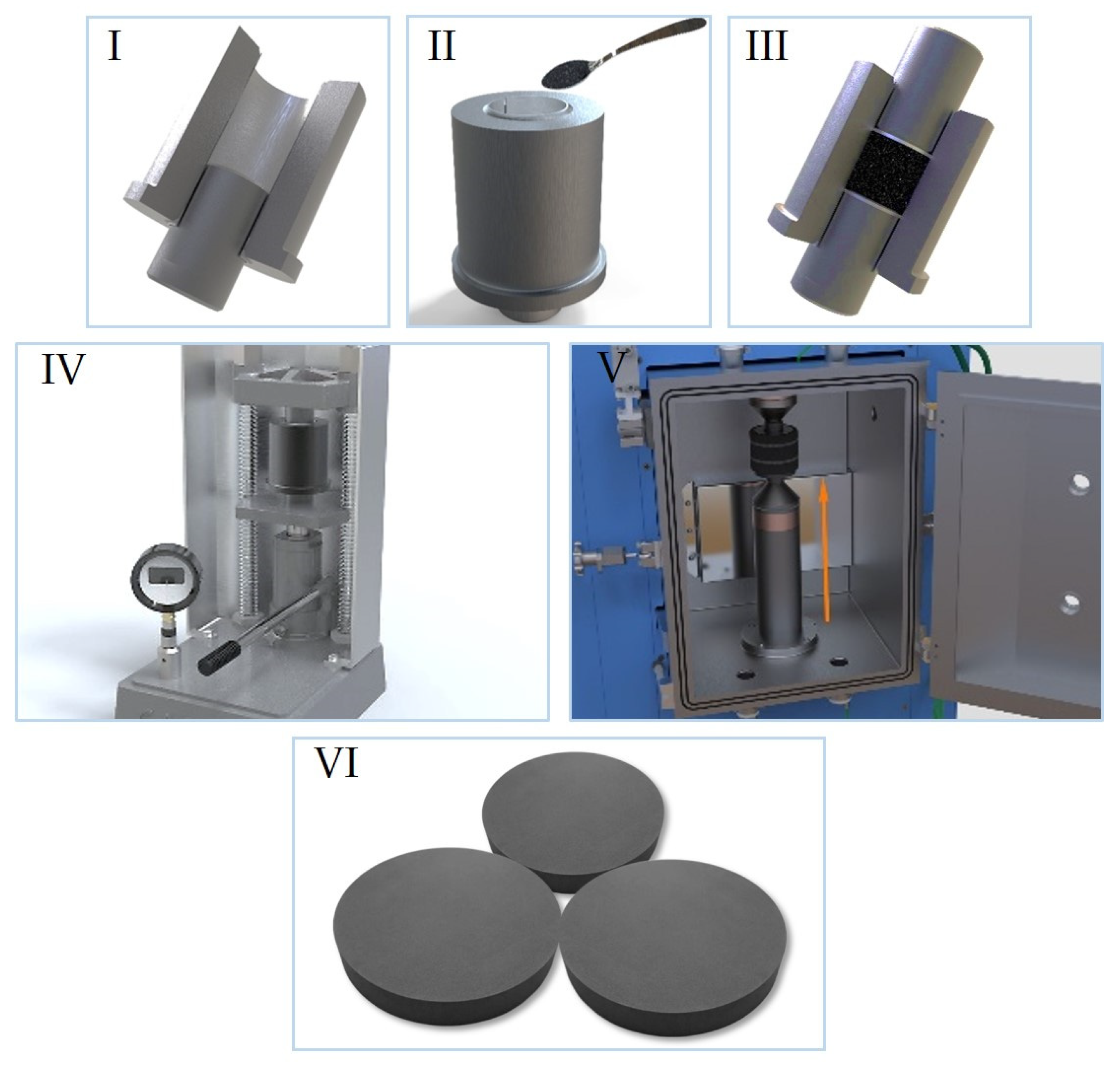

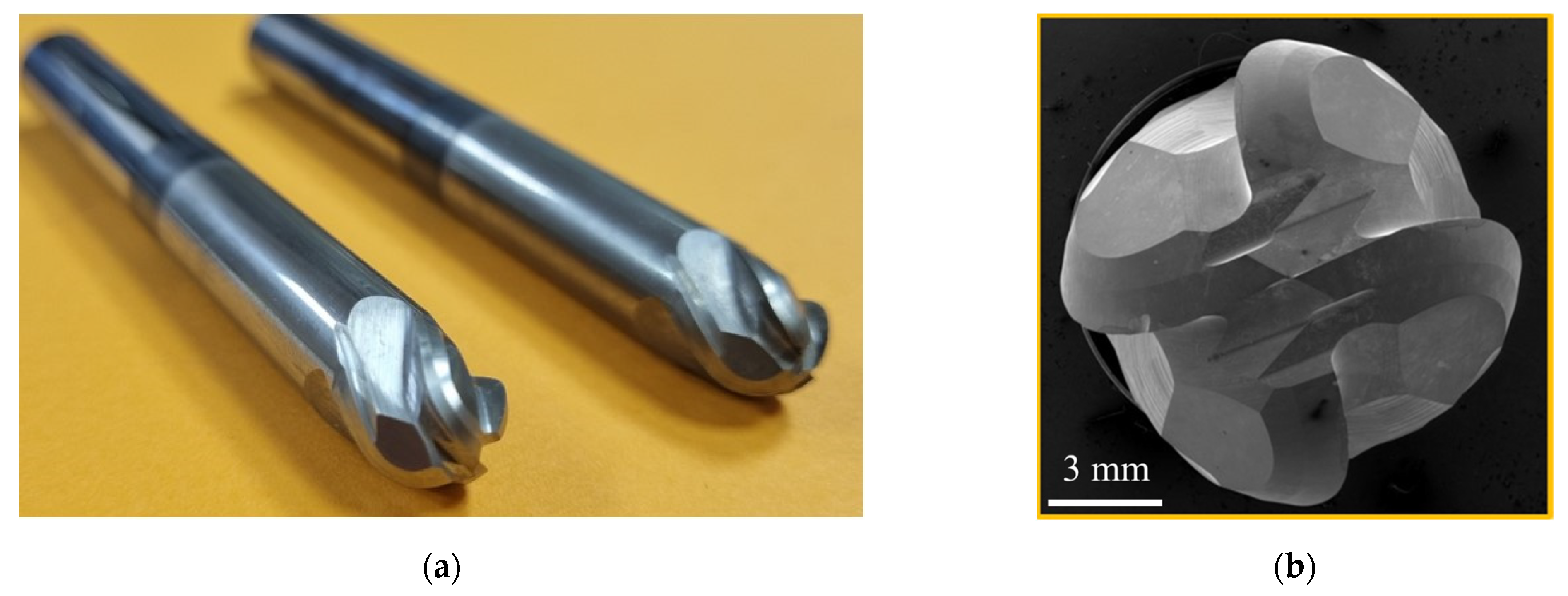
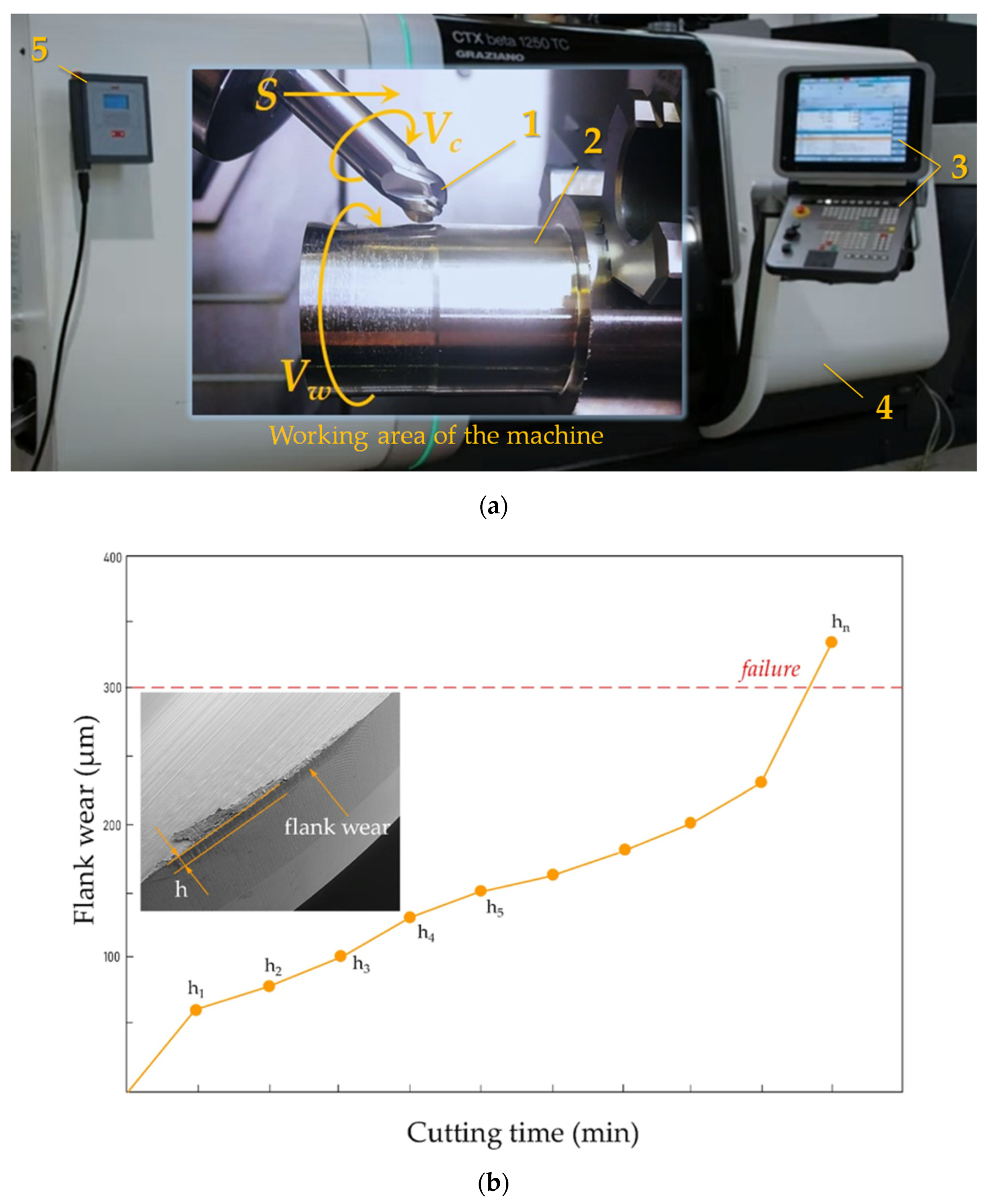








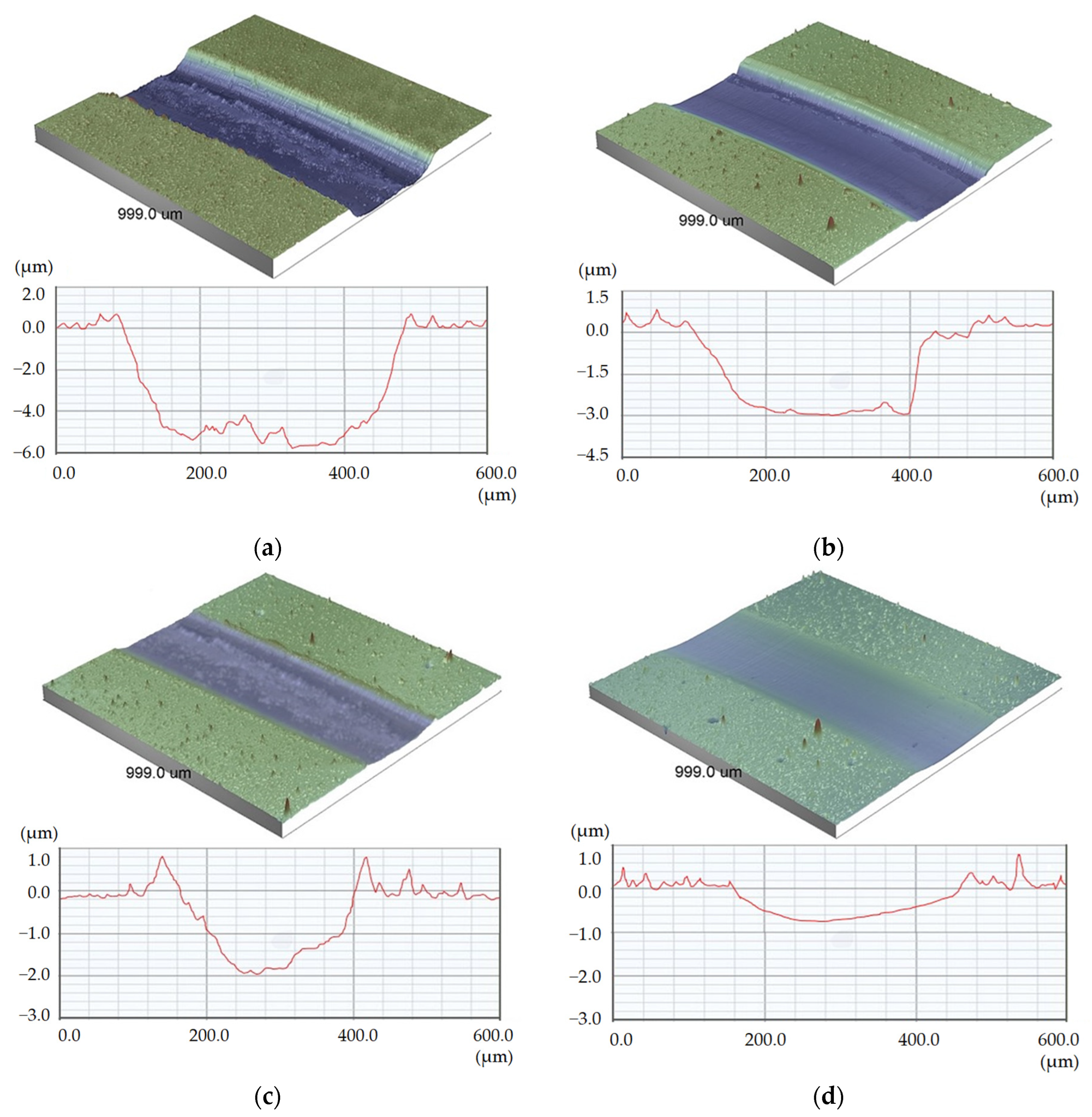
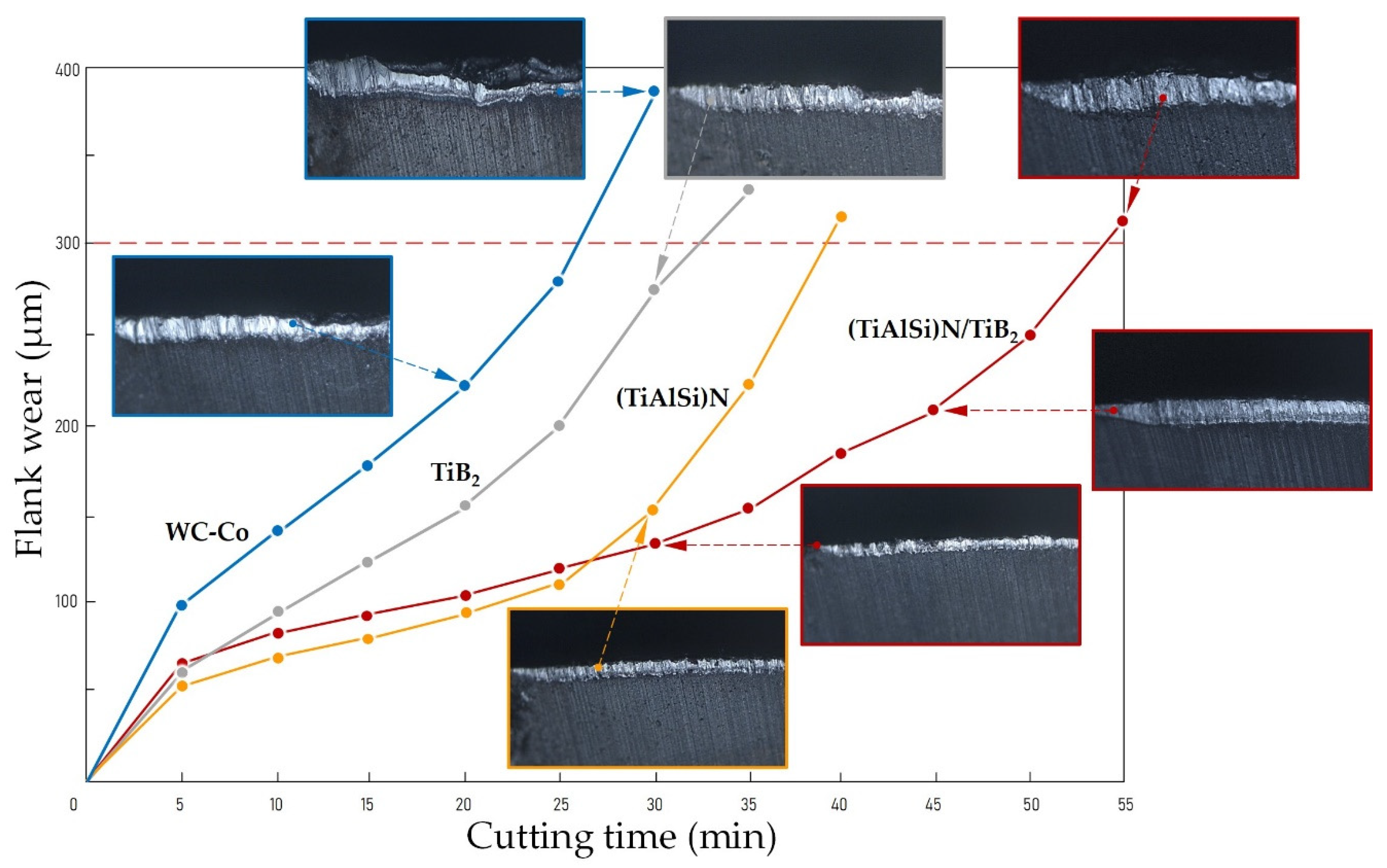
| Parameter | Value | Measuring Unit |
|---|---|---|
| Pre-pressing pressure | 5 | MPa |
| Sintering temperature | 1500, 1600, 1700, 1800, 1900 | °C |
| Sintering pressure | 5 × 10−5, 6.5 × 10−5, 8 × 10−5 | MPa |
| Isothermal holding time | 3, 5, 10 | min |
| Chamber operating pressure | 5 × 10−6 | MPa |
| Parameter | Value | Measuring Unit |
|---|---|---|
| Discharge bias | 200, 300, 400, 500, 600 | V |
| Argon pressure | 0.2, 0.4, 0.6, 0.8, 1.0 | Pa |
| Deposition time | 30, 40, 50, 60, 70 | min |
| Parameter | Value | Measuring Unit |
|---|---|---|
| Outer diameter | 12 | mm |
| Number of teeth | 4 | pcs. |
| Total length | 75 | mm |
| Cutting part length | 30 | mm |
| Tool material | KFM 39 | - |
| Element | Ni | Cr | Nb | Mo | Fe | Ti | Al | Co | Mn | Si | Rest |
|---|---|---|---|---|---|---|---|---|---|---|---|
| % | 58.0 | 20.8 | 5.5 | 3.1 | 3.0 | 1.4 | 0.8 | 0.6 | 0.32 | 0.3 | 0.73 |
| Parameter | Value | Measuring Unit |
|---|---|---|
| Metal-working machine | CNC mill and turn center, CTX beta 1250 TC (DMG MORI Co., Ltd., Tokio, Japan) | - |
| Material and shape of the workpiece | Inconel 718, round rod | - |
| Workpiece diameter | 60 | mm |
| End mill rotation frequency | 7000 | min |
| End mill rotation speed | 263.7 | m/min |
| Workpiece rotation speed | 1.75 | m/min |
| Cutting feed | 0.04 | mm/tooth |
| Cutting depth | 0.25 | mm |
| Flank wear limit value (failure criterion) | 300 | μm |
| Sintering Temperature, °C | Density (%) of Sintered TiB2 Targets | |||
|---|---|---|---|---|
| 0 vol.% Ti | 2 vol.% Ti | 4 vol.% Ti | 6 vol.% Ti | |
| 1500 | 77 | 83 | 94 | 87 |
| 1600 | 81 | 85 | 97 | 89 |
| 1700 | 84 | 88 | 99 | 92 |
| 1800 | 82 | 87 | 98 | 90 |
| 1900 | 81 | 87 | 95 | 85 |
| Type of Coating | TiB2 Coating Thickness (μm) | Critical Load Value (N) | Elastic Modulus, GPa | |
|---|---|---|---|---|
| Lc1 | Lc2 | |||
| without subcoating | 1.0 | 22 ± 1 | 29 ± 2 | 365 ± 7 |
| 2.0 | 15 ± 3 | 23 ± 3 | 390 ± 8 | |
| 2.5 | 12 ± 2 | 18 ± 4 | 472 ± 8 | |
| with subcoating (TiAlSi)N | 1.0 | 25 ± 1 | 34 ± 1 | 332 ± 6 |
| 2.0 | 18 ± 2 | 31 ± 2 | 366 ± 7 | |
| 2.5 | 14 ± 3 | 23 ± 2 | 446 ± 8 | |
Disclaimer/Publisher’s Note: The statements, opinions and data contained in all publications are solely those of the individual author(s) and contributor(s) and not of MDPI and/or the editor(s). MDPI and/or the editor(s) disclaim responsibility for any injury to people or property resulting from any ideas, methods, instructions or products referred to in the content. |
© 2024 by the authors. Licensee MDPI, Basel, Switzerland. This article is an open access article distributed under the terms and conditions of the Creative Commons Attribution (CC BY) license (https://creativecommons.org/licenses/by/4.0/).
Share and Cite
Grigoriev, S.N.; Volosova, M.A.; Fedorov, S.V.; Mitrofanov, A.P.; Gurin, V.D.; Okunkova, A.A. Creation of Tool Coatings Based on Titanium Diboride for Highly Efficient Milling of Chromium–Nickel Alloys. J. Manuf. Mater. Process. 2024, 8, 210. https://doi.org/10.3390/jmmp8050210
Grigoriev SN, Volosova MA, Fedorov SV, Mitrofanov AP, Gurin VD, Okunkova AA. Creation of Tool Coatings Based on Titanium Diboride for Highly Efficient Milling of Chromium–Nickel Alloys. Journal of Manufacturing and Materials Processing. 2024; 8(5):210. https://doi.org/10.3390/jmmp8050210
Chicago/Turabian StyleGrigoriev, Sergey N., Marina A. Volosova, Sergey V. Fedorov, Artem P. Mitrofanov, Vladimir D. Gurin, and Anna A. Okunkova. 2024. "Creation of Tool Coatings Based on Titanium Diboride for Highly Efficient Milling of Chromium–Nickel Alloys" Journal of Manufacturing and Materials Processing 8, no. 5: 210. https://doi.org/10.3390/jmmp8050210
APA StyleGrigoriev, S. N., Volosova, M. A., Fedorov, S. V., Mitrofanov, A. P., Gurin, V. D., & Okunkova, A. A. (2024). Creation of Tool Coatings Based on Titanium Diboride for Highly Efficient Milling of Chromium–Nickel Alloys. Journal of Manufacturing and Materials Processing, 8(5), 210. https://doi.org/10.3390/jmmp8050210









